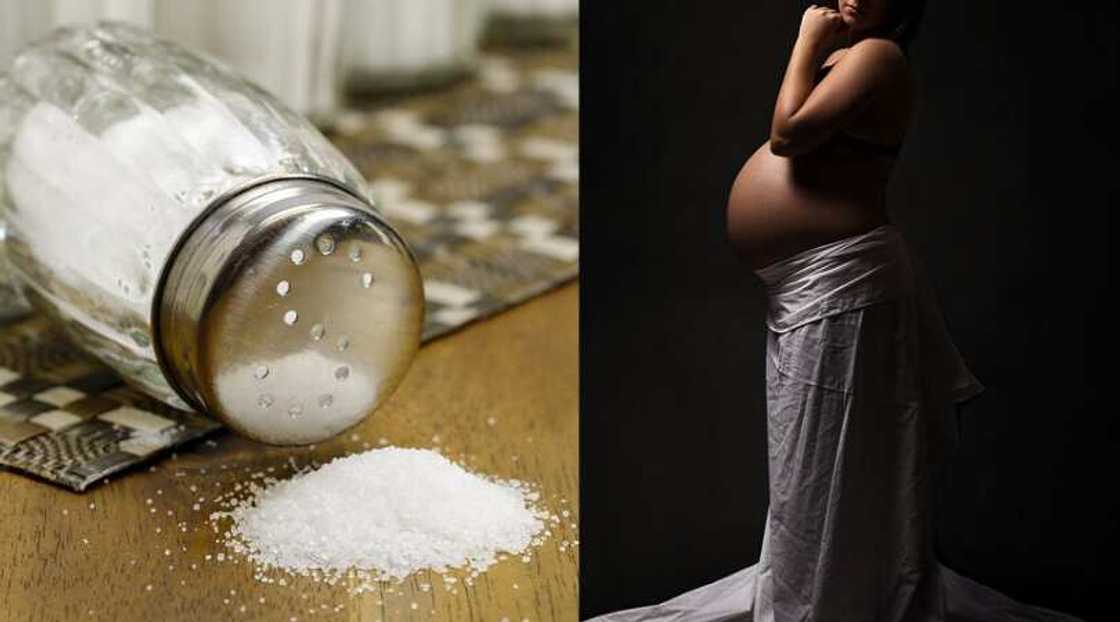Conducting a pregnancy test with salt is one of the most commonly used homemade tests. While there is no strong scientific evidence to prove that a pregnancy test with salt and urine is accurate, it is much cheaper than the commercial kits because everyone has a bit of salt in their kitchen. There are lots of ways of finding out if you are going to become a mother. Today, we want to get you acquainted with them. Dr. Alyssa Deck, a gynecologist and Chief Medical Officer at Bonafide Health, provides expert insights on the effectiveness, limitations, and reasons behind the salt pregnancy test's popularity.

Source: UGC
TABLE OF CONTENTS
How can we check pregnancy at home naturally? Well, one way is to do a pregnancy test with salt in your home. The simple to find requirements are some salt from your kitchen cabinet and your urine. You just blend the two, and within a couple of hours, you can determine whether you are carrying a child in your tummy or not.
Number one homemade pregnancy test: Pregnancy test with salt
A homemade pregnancy test with salt is a popular way of determining if a woman is with a child or not. However, there is a lack of adequate scientific findings to prove that the outcome is accurate.
The steps for this test are quite simple and straightforward. How does the salt pregnancy test work? The results are dependent on the reaction between the salt and the human chorionic gonadotropin hormone that is produced in the body when a woman conceives.
It is worth noting that store-bought kits test for the presence of this hormone as well. If you are intrigued by this information, let us get to the information on how to do a pregnancy test with salt and urine at home.
What is the salt pregnancy test, and how is it supposed to work?
Dr. Alyssa Deck, a gynecologist and Chief Medical officer at Bonafide Health, explained in an interview that, as the name is, a salt pregnancy test is a do-it-yourself (DIY) test to check for pregnancy. She elaborates:
It should be emphasized that this is not a medically validated or reliable test, and any result obtained should be confirmed with a urine or blood pregnancy test or pelvic ultrasound if needed.Dr. Dweck also provided tips on how the salt pregnancy test works. She outlined:
- Materials – plain table salt, urine, and a bowl (non-porous and clear).
- Method - Add a small amount of first-morning urine to a few tablespoons of salt in a bowl. After waiting for a few minutes to a few hours, a "milky," "cheesy," "clumped up," or "fizzy" result suggests a positive result, while no change to the salt mixture suggests a negative result.
The expert suggests that the test results can be challenging to interpret and are not definitive; thus, they might prove unreliable.
Is there any scientific basis or evidence supporting the effectiveness of the salt pregnancy test?
Dr. Dweck said no medical literature supports the salt pregnancy test. She clarifies:
The claim is that the salt reacts with HCG, the hormone produced by the ovary in early pregnancy, which turns a common over-the-counter urine pregnancy test positive.Dr. Dweck emphasized that the main concern with DIY tests like salt pregnancy tests is the risk of inaccurate positive or negative results. She also mentioned that the limitations of using a salt pregnancy test to determine pregnancy is that it is not scientifically or medically based. She advised that individuals should not base future management on such results.
Dr. Dweck explains the reason why DIY tests like salt pregnancy tests are still popular despite the lack of scientific support. She said:
Popularity lies in folklore. Also, this is an easily accessible, affordable, and anonymous test. Any salt pregnancy test (positive or negative), with or without symptoms of early pregnancy and/or missed menses, should be checked with a super reliable urine pregnancy test.
Source: UGC
How can I do pregnancy test with salt and urine?
Follow the guide below to know whether or not you are with a child at the comfort of your home;
Requirements
All you need are a clear glass or transparent container (you can use a clear plastic container too) and common salt.
Procedure
- Typically, women are advised to use a fresh sample of urine, preferably from the first exertion in the morning, i.e. immediately after waking up.
- Add a bit of salt to your urine sample (about three dashes.)
- You will observe the results in about two hours.
What does a positive salt pregnancy test look like?
After the time has elapsed, you can observe to know if you are with a child or not. The possible outcomes are;
- Salt pregnancy test positive results – The test is positive if you observe the formation of white foam. Does salt dissolve in urine during pregnancy? It does not.
When one is carrying a child, the human chorionic gonadotropin hormone in the pee reacts with the salt, causing the sample to have a change in texture. It appears to be cheesy or milky.
What does a negative pregnancy test with salt look like?
- Negative results – If the sample remains unchanged, then the outcome is negative. You have probably not conceived.

Source: UGC
How early can pregnancy be detected?
In the present day, a lady can test whether or not they conceived as early as four to five days before a missed period using the commercial testing kits.
However, the store-bought kits are more reliable if used at least one day after a missed period. This is because it takes time for the human chorionic gonadotropin hormone to be produced in adequate amounts that can be detected.
NB: It is essential to check the instructions of use on the packaging before use.
After how many days pregnancy can be confirmed by urine test?
It can be done at least one to two weeks after coitus.
When to do a pregnancy test
You can do the test at least one day after a missed period for more accurate results. At this point, there are adequate levels of human chorionic gonadotropin.
If the store-bought kits are not available or you wish to test using the readily available ingredients, you can do a home test.
If the salt test is done earlier than this, the results may not be positive because it takes time for the hormone to be produced in adequate amounts. If the result is negative and you are convinced otherwise, you can test again after a few days.

Source: UGC
Points to note
- It is necessary to note that the test using salt does not give you an iron-clad guarantee. The sample can become foamy after the salt comes in contact with the urine of a woman who is not pregnant.
- Like all other homemade tests, the salt test is best done in the morning just after waking up. This is because the pee has a higher concentration of the human chorionic gonadotropin hormone.
- Pregnancy tests that can be done at home are relatively cheap. You probably will not even have to leave the house, since everything you need is already in your closet, pantry, or garden.

Source: UGC
- It only takes simple instructions to make a homemade test. Such tests use the same fundamental scientific principles as those used in modern medicine.
- Although homemade pregnancy tests can indicate the presence or absence of pregnancy in a woman, they should not be a complete replacement for prenatal and antenatal care. The latter is absolutely necessary for a healthy mommy and baby.
- Natural ways of testing for pregnancy should not replace modern tests that are more accurate. You should take advantage of all the benefits of medical advancements in the present-day world.
Other homemade tests to try
You can also use the following ingredients or products that are commonly available in most homes.
Shampoo
In a small bowl, add some water to the halfway mark then add a few drops of the shampoo to the water. Do not mix, and make sure that the shampoo does not froth in water.
Add some morning urine to the mixture and if frothing occurs, congratulations! If there is no frothing, it is negative.
Sugar
Place some sugar (with fine grains) in a container and add some morning pee to it. Sugar clumps will form if you have already conceived.

Source: UGC
Baking soda
We all know that baking soda has numerous uses in the home. Now, take two tablespoons of it and place it in a container.
Add some morning pee, and if the mixture fizzes up, consider it a positive outcome.
Peroxide and Tylenol
You have both peroxide and Tylenol in your cupboard, right? Take a clean container and add about a quarter cup of peroxide followed by two crushed Tylenol tablets. Next, add some morning pee.
Blue colour signifies that you have already conceived.

Source: UGC
Wheat and barley
Take barley and wheat in equal quantities and place them in a clean bowl then add some morning pee. Wait for at least hours before observing.
If the seeds start sprouting, consider it positive and vice versa.
Soap
Take a small bowl and place a piece of soap inside. Next, add a bit of morning pee then chill for about five to six minutes.
If you see some frothing or foaming, it is positive.
Did you know that you can do a pregnancy test with salt and pee in the comfort of your home? However, it takes longer than commercial kits to see the result, and there is no substantial scientific evidence that it is accurate. Even so, you can do it at home for fun.
DISCLAIMER: This article is intended for general informational purposes only and does not address individual circumstances. It is not a substitute for professional help or advice and should not be relied on to make decisions of any kind. Any action taken upon the information presented in this article is strictly at your own risk and responsibility!
Sources:
- Does the Salt Pregnancy Test Really Work? (2019, healthline.com)
- How soon can I do a pregnancy test? (2018, nhs.uk)
- How to Check Pregnancy at Home Without Kit: 11 Reliable Methods (2018, sheroes.com)
- Pregnancy Test With Salt (2019, whattoexpect.com)
- Pregnancy Test With Salt: How It Works And Is It Accurate? (2019, pandagossips.com)
- When You Should Take a Pregnancy Test (2017, healthline.com)
Source: Legit.ng












![[ICYMI] No N500m missing from customer’s account, says Access Bank](https://cdn.punchng.com/wp-content/uploads/2018/09/14183604/20180707-DSC_0077new.jpg)



 English (US) ·
English (US) ·